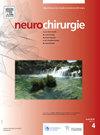颅裂成功后5年随访:脑积水与静脉系统重排的研究进展。
IF 1.4
4区 医学
Q4 CLINICAL NEUROLOGY
引用次数: 0
摘要
颅裂是一种罕见的先天性畸形。双生颅板分离与高发病率和死亡率相关,特别是在全型中,双胞胎共用硬脑膜静脉窦。分离手术后的并发症之一是脑积水。虽然术前需要详细的脑血管成像以确保最佳的手术入路,但术后血管成像对于评估分离手术后脑静脉系统的变化同样重要。病例介绍:分离手术成功地完成了完全垂直双颅与共享硬脑膜静脉窦。一个双胞胎术后出现脑积水,而另一个双胞胎有脑脊液从伤口渗漏。两名双胞胎均接受了LP分流术,恢复良好。然后,我们比较了这对双胞胎的大脑静脉结构,在分离手术前后使用重建CT静脉造影。结论:双胎发育良好且无神经功能缺损的全垂直颅斜双胎成功分离是非常罕见的。根据随访CTV,脑静脉系统重新排列以适应分离手术后血流动力学需求的变化。这可能会给我们对脑静脉系统的新认识,有利于预后良好的双颅畸形。本文章由计算机程序翻译,如有差异,请以英文原文为准。
5-year follow up after successful craniopagus separation: Review on hydrocephalus and venous system re-arrangement
Introduction
Craniopagus is one of the rarest congenital abnormalities. Separation of craniopagus twin is associated with high morbidity and mortality, especially in total type, where the twin had shared dural venous sinuses. One of the complications after separation surgery is hydrocephalus. While detailed cerebral vasculature imaging is needed pre-operatively to ensure most optimal surgical approach, post-operative vasculature imaging is no less important to assess changes in cerebral venous system after separation surgery.
Case presentation
Separation surgery was successfully accomplished in a total vertical craniopagus twin with shared dural venous sinuses. One twin experienced hydrocephalus after surgery, while the other twin had CSF leakage from the wound. LP shunt was placed in both twin and they had good recovery. We then compared the cerebral venous structure in both twins, before and after separation surgery using reconstruction of CT venography.
Conclusion
Successful separation of total vertical craniopagus twin where both twin developed well without any neurological deficit is a very rare occurrence. Based on follow up CTV, cerebral venous system underwent re-arrangement to accommodate changing hemodynamic needs after separation surgery. This might give us new insight about cerebral venous system that favors good prognosis for craniopagus twin.
求助全文
通过发布文献求助,成功后即可免费获取论文全文。
去求助
来源期刊

Neurochirurgie
医学-临床神经学
CiteScore
2.70
自引率
6.20%
发文量
100
审稿时长
29 days
期刊介绍:
Neurochirurgie publishes articles on treatment, teaching and research, neurosurgery training and the professional aspects of our discipline, and also the history and progress of neurosurgery. It focuses on pathologies of the head, spine and central and peripheral nervous systems and their vascularization. All aspects of the specialty are dealt with: trauma, tumor, degenerative disease, infection, vascular pathology, and radiosurgery, and pediatrics. Transversal studies are also welcome: neuroanatomy, neurophysiology, neurology, neuropediatrics, psychiatry, neuropsychology, physical medicine and neurologic rehabilitation, neuro-anesthesia, neurologic intensive care, neuroradiology, functional exploration, neuropathology, neuro-ophthalmology, otoneurology, maxillofacial surgery, neuro-endocrinology and spine surgery. Technical and methodological aspects are also taken onboard: diagnostic and therapeutic techniques, methods for assessing results, epidemiology, surgical, interventional and radiological techniques, simulations and pathophysiological hypotheses, and educational tools. The editorial board may refuse submissions that fail to meet the journal''s aims and scope; such studies will not be peer-reviewed, and the editor in chief will promptly inform the corresponding author, so as not to delay submission to a more suitable journal.
With a view to attracting an international audience of both readers and writers, Neurochirurgie especially welcomes articles in English, and gives priority to original studies. Other kinds of article - reviews, case reports, technical notes and meta-analyses - are equally published.
Every year, a special edition is dedicated to the topic selected by the French Society of Neurosurgery for its annual report.
 求助内容:
求助内容: 应助结果提醒方式:
应助结果提醒方式:


